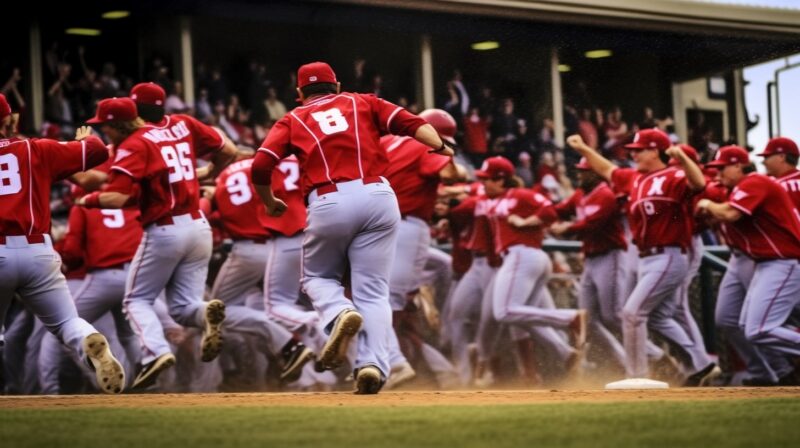College baseball games are a thrilling and beloved part of the sporting landscape, captivating fans with their blend of skill, strategy, and teamwork. In the world of baseball, innings serve as the fundamental building blocks of a game, determining its structure and progression. If you’ve ever wondered how many innings are typically played in a college baseball game, you’ve come to the right place. This article aims to answer that question and provide valuable insights into the nuances of college baseball.
Explanation of Innings
Before diving into the specifics of college baseball games, let’s first understand what an inning represents in the context of baseball. An inning is a unit of play consisting of both offensive and defensive segments. In the offensive half of an inning, the team at bat tries to score runs, while the opposing team assumes defensive positions to prevent scoring. The roles reverse in the defensive half, with the team that was on defense now taking their turn to bat, and vice versa.
Each team has an opportunity to bat and field during an inning, with three outs required to transition from offense to defense and vice versa. An out is recorded when a batter fails to reach base safely or is put out by the defense. At the end of an inning, if both teams have completed their offensive and defensive segments, the game progresses to the next inning.
College Baseball Rules
College baseball games adhere to specific rules and regulations, which may differ from the professional baseball rules followed in Major League Baseball (MLB). These rules are established by the National Collegiate Athletic Association (NCAA) and govern various aspects of the game, including innings.
While there may be slight variations, college baseball generally follows the same basic rules as professional baseball. However, the NCAA has implemented some specific regulations to cater to the unique nature of college sports, including limitations on the number of scholarships, season length, and roster sizes. It’s essential for players, coaches, and fans to be familiar with these rules to fully appreciate and participate in college baseball games.
Nine-Inning Games
In college baseball, most games follow the standard format of nine innings. This tradition stems from the historical significance of nine innings in baseball. The number nine has deep roots in the sport, representing the perfect balance between offense and defense, allowing for a fair and comprehensive display of skills.
Playing nine innings allows teams ample opportunities to strategize, adapt, and showcase their talents in a regulated timeframe. It strikes a balance between providing an engaging and competitive game while also considering factors such as player fatigue and time constraints.
Extra-Inning Games

While most college baseball games conclude within the standard nine innings, there are situations where games extend beyond this limit. When the score is tied at the end of nine innings, extra innings are played to determine a winner. Extra-inning games can be incredibly exciting, as they test the endurance, resilience, and mental fortitude of both teams.
In extra-inning games, each subsequent inning follows the same structure as the previous nine innings, with both teams alternating between offense and defense. However, to avoid excessively long games, especially during regular-season play, specific rules and procedures are in place to expedite the process and break ties.
To manage the duration of extra-inning games, the NCAA has introduced tiebreaker rules in recent years. These rules typically involve placing a runner on second base at the start of each half-inning, providing an immediate scoring opportunity. This alteration aims to increase the likelihood of runs being scored and accelerate the pace of the game.
Conference and Tournament Games
In college baseball, conference and tournament games may have different rules regarding innings compared to regular-season games. These variations are typically established by the respective conferences or tournament organizers. While the nine-inning format remains prevalent, some conferences may adopt modifications such as doubleheaders or reduced-inning games to accommodate scheduling constraints or other considerations.
It’s essential for teams and fans to be aware of any specific regulations or variations followed in conference and tournament play. Understanding these rules ensures a comprehensive grasp of the game and allows for maximum enjoyment of the college baseball experience.
Weather or Time Constraints

Like any outdoor sport, college baseball games are susceptible to weather conditions and time constraints. Inclement weather, such as rain or lightning, can interrupt or delay games, potentially resulting in the need for abbreviated contests. In such cases, games may be called off, suspended, or even reduced to a predetermined number of innings, depending on the severity and duration of the weather disruption.
Additionally, time constraints can also impact the number of innings played. College baseball games are often scheduled back-to-back or as part of doubleheaders, with limited time available between games. As a result, if a game goes into extra innings or if weather delays occur, the duration of subsequent games may be shortened to accommodate the schedule. These factors emphasize the need for adaptability and flexibility in the game of college baseball.
Mercy Rule
In college baseball, as in many other sports, a mercy rule is in place to prevent unnecessarily lopsided scores and to expedite the conclusion of games that have become highly one-sided. The mercy rule allows for a game to be ended earlier than the standard nine innings if a team is leading by a significant margin after a specified number of innings have been played.
The specific criteria for invoking the mercy rule can vary depending on the level of college baseball and the conference rules in place. Once the mercy rule is triggered, the game is concluded, and the team in the lead is declared the winner. This rule ensures that games maintain a reasonable competitive balance while respecting the efforts of both teams involved.
Examples of Notable College Baseball Games

Throughout the history of college baseball, there have been several remarkable games that have pushed the boundaries of innings played. These games often become part of the sport’s folklore, capturing the imagination of fans and players alike.
One such example is the famous 25-inning marathon game between the University of Texas and Boston College in the 2009 NCAA tournament. The game lasted a staggering seven hours and three minutes, with both teams displaying extraordinary determination and skill. Such games serve as a testament to the enduring spirit and excitement of college baseball.
Overtime and Tiebreaker Scenarios
In postseason play, including conference tournaments and the College World Series, overtime scenarios and tiebreakers come into play when games are tied at the end of the standard nine innings or extra innings. The goal is to determine a winner and progress the tournament.
Overtime in college baseball often involves employing a tiebreaker format to expedite the resolution. In these scenarios, runners are placed on base at the start of each half-inning, usually with specific rules regarding how runners are selected or positioned. This setup presents an immediate scoring opportunity for both teams and helps to ensure that games conclude within a reasonable timeframe.
Factors Influencing Game Length

Several factors can influence the length of college baseball games and, consequently, the number of innings played. Pitching changes, offensive strategies, and the overall pace of the game all contribute to the duration of each inning and the game as a whole.
Pitching changes, for instance, can introduce additional time to the game. Coaches may strategically replace pitchers to exploit matchups, conserve energy, or introduce a fresh arm. Similarly, offensive strategies, such as long at-bats, frequent base stealing attempts, or bunting, can extend the duration of an inning.
Game pace, including the efficiency of the players and umpires in keeping the game moving, also plays a role in the overall length. A fast-paced game with minimal delays between pitches and innings will naturally progress more quickly than a game with extended breaks or prolonged deliberations.
While observing the duration of college baseball games, you might notice athletes munching on a peculiar snack, often seen in the form of small, crunchy kernels. To understand this intriguing habit, check out our article on the reasons behind baseball players’ fondness for sunflower seeds.
Frequently Asked Questions (FAQ)
1. How does the mercy rule work in college baseball?
The specifics of the mercy rule can vary depending on the league or conference. Generally, if a team is leading by a predetermined number of runs after a specified number of innings, the game may be called, and the leading team is declared the winner.
2. Are there any restrictions on the number of innings a pitcher can pitch in a college baseball game?
Yes, there are rules and limitations on the number of innings a pitcher can pitch in a college baseball game to prevent overuse and protect player safety. These restrictions may vary based on conference or league regulations.
3. Are there any strategies used to manage pitching in long college baseball games?
In extended or extra-inning games, college baseball teams often employ strategic pitching management, including the use of relief pitchers, to preserve the stamina and effectiveness of their pitching staff over the course of the game.
4. Can a college baseball game end in a “walk-off” win?
Yes, a college baseball game can end in a “walk-off” win, which occurs when the home team scores the winning run in the bottom of the final inning.
5. Can college baseball games have different innings formats in different conferences?
While the standard format for college baseball games is nine innings, there can be slight variations in innings formats, especially in non-conference play or in leagues with specific rules and regulations.
Conclusion
Understanding the number of innings in a college baseball game is essential for fans, players, and coaches alike. Most college baseball games adhere to the standard format of nine innings, reflecting the sport’s historical traditions and allowing for a comprehensive display of skills.
However, there are situations where games may extend beyond nine innings, particularly in the case of tied scores. Extra-inning games and tiebreaker scenarios add excitement and challenge to the sport, testing the endurance and mental fortitude of the teams involved.
Conference and tournament games, weather or time constraints, and the mercy rule can all impact the number of innings played in college baseball. Additionally, factors such as pitching changes, offensive strategies, and game pace influence the overall length of each game.
By understanding the rules and variations surrounding innings in college baseball, fans can fully immerse themselves in the sport and appreciate the strategic depth and competitive spirit it offers. So grab your glove and rally behind your favorite team as you witness the captivating world of college baseball unfold before your eyes.







